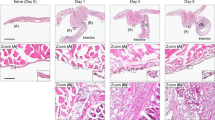Summary.
This article reviews the molecular basis of cell adhesion and its possible implications in surgery. Adhesion of circulating cells to endothelial cells is mediated by a variety of celladhesion molecules. The first steps in the celladhesion cascade (rolling, tethering) are regulated by selectins (P, E, L selectin). Stable adhesion and transmural migration predominantly involve integrins (LFA-1, etc.) and members of the immunoglobulin supergene family (ICAM-1, etc.). The mechanisms of leucocyte-endothelial interaction are markedly similar in various organs under both physiological and pathophysiological conditions. However, it is likely that cell trafficing to specific tissues/organs (e.g., homing) is regulated by additional organ-specific, topical adhesion molecules (e. g., MAdCAM-1). In surgery, cell adhesion molecules are involved in organ-transplantation pathology (ischemia/reperfusion injury, rejection), inflammation (e.g., chronic inflammatory bowel diseases), tumor metastasis. Animal experiments with anti-adhesive substances show that blocking the leukocyte-endothelial interaction reduces the cellular inflammatory infiltrate and organ rejection. The transfer of experimental data into clinical practice requires further understanding of the regulators of cell adhesion (cytokines, chemoattractant substances, etc.) and the specificity of the process. Current experimental data suggest that early intervention in cell-adhesion mechanisms may offer innovative therapeutic strategies.
Zusammenfassung.
Die Adhäsion zirkulierender Zellen an Endothelzellen wird durch Zelladhäsionsmoleküle vermittelt und läuft kaskadenförmig ab. Die ersten Schritte dieser Zelladhäsionskaskade (rolling, tethering) werden vornehmlich durch Selektine (P-, E- und L-Selektin) reguliert, während an der stabilen Zelladhäsion und der anschließenden Migration hauptsächlich Integrine (LFA-1 u. a.) und Mitglieder der Immunglobulinsupergenfamilie (ICAM-1 u. a.) beteiligt sind. Die Leukocytenendothelinteraktion läuft unter physiologischen und pathophysiologischen Bedingungen sowie in verschiedenen Organen sehr ähnlich ab; möglicherweise wird die Zellwanderung in individuelle Gewebe/Organe (z. B. beim homing) durch zusätzliche organspezifische, topische Adhäsionsmoleküle (wie MAdCAM) ergänzt. Die mögliche klinisch-chirurgische Bedeutung von Zelladhäsionsmolekülen kommt insbesondere in der Transplantationsmedizin (Ischämie/Reperfusion und Rejektion), bei Entzündungen (z. B. chronisch entzündliche Darmerkrankungen) und in der Tumormetastasierung zum Tragen. Die Ergebnisse tierexperimenteller Untersuchungen zur Antiadhäsionstherapie zeigen, daß durch Blockade der Leukocytenendothelinteraktion die Entstehung von Entzündungsinfiltraten und die Abstoßungsreaktion verhindert werden können – Erfahrungen im Humansystem liegen bisher nur vereinzelt vor. Voraussetzung für die klinische Umsetzung ist u. a. ein besseres Verständnis der Regulation von Zelladhäsionsmolekülen (Cytokine, chemotaktische Substanzen etc.) und der Spezifität dieser Prozesse. Schon heute legen die experimentellen Daten nahe, daß durch Interaktion mit dem Zelladhäsionssystem durch frühe Beeinflussung eines grundlegenden pathophysiologischen Prinzips ein innovatives Therapiekonzept etabliert werden kann.
Similar content being viewed by others
Author information
Authors and Affiliations
Rights and permissions
About this article
Cite this article
Schürmann, G. Zelladhäsion Molekulare Grundlagen und erste Aspekte für die Chirurgie. Chirurg 68, 477–487 (1997). https://doi.org/10.1007/s001040050216
Issue Date:
DOI: https://doi.org/10.1007/s001040050216




